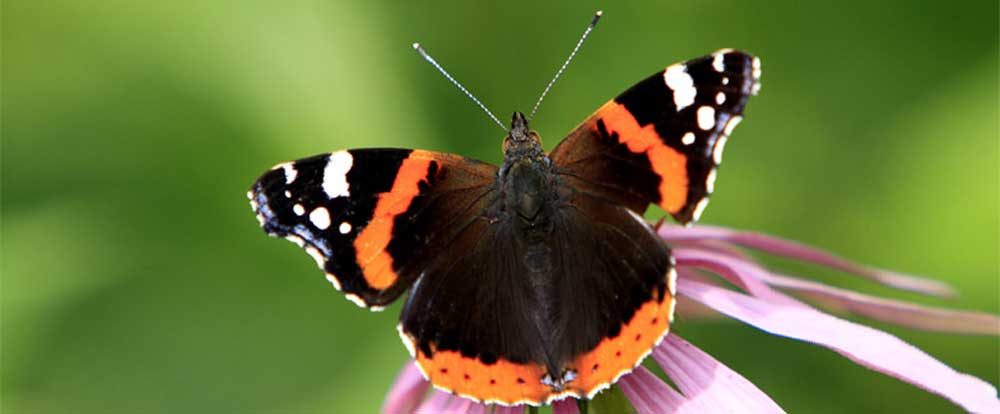Butterflies are beautiful creatures which typify summer. Enhancing our garden with a splash of colour, many butterflies are commonly seen across Britain – others are a little rarer and you’ll be lucky to spot one.
This year has been great for butterflies, with indications suggesting it has been the best summer in a decade, in terms of the number of butterflies and the variety of species that have been spotted.
The British public has been taking part in the Big Butterfly Count, organised by the charity, Butterfly Conservation, to see whether it has truly been a record-breaking year. People have been asked to submit online how many butterflies they have seen in a sunny spot in any 15-minute period.
The survey ran for three weeks, ending on 11th August. The results are currently being collated and will be revealed shortly. So, how do you know if you’ve been lucky enough to see a rare species? Read on!
Red Admiral
One of the most common species in Britain, the Red Admiral is black, with red fringes on the rear wings, red stripes on the front wings and white markings towards the tips of the wings.
Widespread across the UK in the summer months, the majority of Red Admirals migrate here from central Europe and can often found in our gardens. The caterpillars eat mainly nettles, forming a protective cocoon from folded nettle leaves. Adult butterflies feast on flowers, including bramble, buddleia and ivy. They enjoy a diet of nectar and will also eat sticky fruits.
Peacock
Not as prominent as the Red Admiral, Peacock butterflies are also commonly found in Britain – they have spread to the far north of Scotland. Featuring reddish-purple wings, with a spotted pattern that resembles eyes, they have quite a dramatic appearance.
Their pattern has a purpose: the butterfly scares off predators, including birds, by flashing its wings open to reveal the eye-like markings. It can also hiss to deter predators, including bats and mice.
The caterpillars feed off nettles, while the adult butterflies eat garden plants such as buddleia. They tend to be found feeding more in late summer, as they build up their fat reserves ready for their winter hibernation.
Brimstone
You’re lucky if you spot a Brimstone, as the male is the only big yellow butterfly in Britain. The female is slightly less colourful, as she is more of a cream colour. She can be confused with the more common large white butterfly.
The Brimstone can be found in parts of England and Wales, but is rarely seen in Scotland and Northern Ireland. Relatively long-lived, the species will survive for around a year. They hibernate amid plant cover such as ivy, as their wings resemble leaves and provide great camouflage.
The caterpillars feed on buckthorn and alder buckthorn leaves, while the butterflies particularly enjoy the purple flowers of thistles.
Holly blue
The Holly blue looks similar to the common blue, although it doesn’t have any orange dots on its wings – the distinguishing feature of the common blue. The Holly blue is widespread in the south of England and has gradually begun to spread northwards. A colony has recently been found as far north as Edinburgh, in Scotland. It is seldom seen in Northern Ireland, except in the east.
It frequents woodlands and gardens, where the caterpillars feed on flower buds and the berries from ivy, holly, dogwood and spindle. The butterflies mainly feed on honeydew, which is a liquid secreted on to plants by aphids.
The population can be severely affected by the parasitic wasp, which grows inside the caterpillars and pupae, causing them to die.
Butterflies and the weather
Butterflies are affected by the weather and are vulnerable to climate change. Highly sensitive, they depend on environmental traits, such as the temperature, to trigger vital functions including reproduction, hibernation and migration.
According to Butterfly Conservation, extreme weather conditions can have a detrimental effect on the butterfly population. In 2016, a study by scientists from the University of East Anglia investigated how extreme climatic events impacted on our butterflies.
Collected over 37 years, they studied data on the prevalence of butterflies from more than 1,800 UK sites to ascertain whether extreme weather events, such as rain, drought, heat or cold, had affected the population.
It was found that heavy rain was most damaging to butterflies in the pupal life stage, with more than one-quarter of them being detrimentally affected.
Extreme heat
Extreme heat was most dangerous to adult butterflies, affecting more than 50% of them, partly due to the fact it increased diseases.
In 1976, the long, exceptionally hot summer was a disaster for butterflies, as plants withered due to the hot conditions and lack of water, which left the butterflies short of food.
Unseasonal temperatures in the spring are a cue for butterflies to come out of winter hibernation early. Then, when a cold snap sets in, they can die.
Sir David Attenborough has publicly supported the Big Butterfly Count, explaining that the majority of butterfly species have been gradually declining over the past four decades. The ideal weather conditions are a cold winter, followed by a late spring and settled weather in the summer.
Aimed at contributing to our conservation knowledge, the Big Butterfly Count is also backed by mental health charity Mind, as research has shown that spending time surrounded by nature can help with problems such as anxiety and depression.
If you love seeing butterflies and other wildlife in their natural habitat, visit picturesque Pinetum Gardens, in St Austell, Cornwall.
The stunning 30-acre estate features beautiful ornamental gardens and open parkland, where more than 6,000 species of plants and mature trees will surely have you feeling at one with nature.

